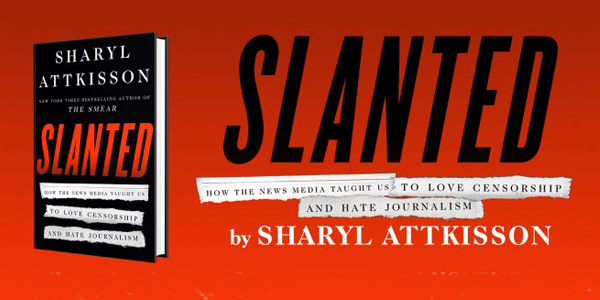
One of the Last Honest Reporters Speaks Out
Written by Elise Cooper
Slanted is the third book by Sharyl Attkisson, and as with her other two, it is a refreshing read. It is nice to know that there are still independent journalists who put fact over opinion, and she is one of those. To no one’s surprise, she talks about the shift in the news, from a focus on reporting the facts to more on trying to push a narrative on the American people.
Attkisson begins Slanted by talking about George Orwell’s book 1984. Attkisson tells the story of “the hapless protagonist, Winston Smith, a government records editor at the Ministry of Truth — which is a job that’s all about lies. The modern media have also discovered how to carefully filter information on the front end to make sure that only the ‘correct’ view is presented in the first place. That way, the story never has to change.”
She directly told American Thinker, “We in the media have, to a frightening degree, gotten on board with the efforts to convince the public that they do not need or deserve access to all information, only that which powerful interests see fit for them to have.”
Did anyone ever wonder how the media constantly use anonymous sources to push their narrative? Attkisson recently testified before a U.S. Senate Committee her beliefs:
Under Trump, the press very publicly announced it was suspending its longstanding journalism ethics and guidelines to cover someone they claimed was uniquely dangerous. They began carelessly publishing information from anonymous sources “without evidence,” even when such sources repeatedly proved wrong. When I was at CBS News, we followed strict guidelines as to when and how anonymous sources could be used. For example, anonymous sources were to be used only as a last resort if the information could not be gathered in another way. We were to disclose with as much specificity as possible any conflicts of interest the party might have and what type of position or access that person held or holds. Now, instead of quoting others, journalists merely make claims and determinations themselves, blending their opinion into hard news reporting, telling people which side is supposedly correct rather than letting the public decide. They even declare information to be fact as if they had personally confirmed it, when they could not possibly have done so.
In the book, she also speaks about social media, Twitter, and Google along with mainstream media regarding the way they redefined their roles. “The same powerful interests that figured out how to successfully dominate news narratives in the first decade and a half of this century saw in 2016 that people could still get unfettered access to information online. So, they set about to change that. That’s what we’re seeing today. Those interests have successfully intervened to convince Big Tech to controversialist or censor information, views, scientific studies, and other material that these powerful interests do not want people to see or believe.”
A book chapter was devoted to “The New York Times: All the Narratives Fit to Print.” Along with The Washington Post, and many others, it could now be considered “Democratic state media,” just as in Russia and China. There are so many examples to draw from. Looking at a recent tweet, the N.Y. Times called the killing of an Iranian nuclear scientist outrageous considering that “Iranian officials, who have always maintained that their nuclear ambitions are for peaceful purposes, not weapons.” Really? This goes along with what The Washington Post did regarding the killing of ISIS terrorist Abu Bakr al-Baghdadi. First, the headline called him the “terrorist-in-chief,” but it was changed to “”Abu Bakr al-Baghdadi, austere religious scholar at the helm of Islamic State.”
Then there is the op-ed written for the Times by U.S. Senator Tom Cotton, an Arkansas Republican, titled “Send in the Troops.” It advocated for dispatching military assistance to U.S. cities wracked by violence amid protests against police brutality. After the piece was published, the New York Times staff had an internal revolt because Cotton’s words were “incendiary.” The Times caved and put an editorial note blaming the editing process for the piece even being published. Attkisson noted, “It is a strange place, indeed, where news reporters can editorialize, but op-ed editorials cannot. Senator Cotton’s piece is typical of topics tackled in op-ed pieces. Most people would argue that’s the point: to present diverse views.”
Continuing the saga of the New York Times, in her chapter “Media VS Media,” she tells the story of what was done to her. In an article titled, “From Jerry Falwell Jr. to Dr. Drew: 5 Coronavirus Doubters,” written by Jeremy Peters, he falsely accused her of being a coronavirus doubter.
Recounting it, “I did a triple-take. I have never suggested, let alone ‘insisted,’ that coronavirus is ‘overhyped’ as Peters falsely reported. I soon discovered Peters made a shocking series of false claims in his story. He deceptively altered a quote to try to prove his narrative. I quickly saw that he apparently did not personally review anything I’d written or said about coronavirus in context. Everything he claimed about me in his outlandish article was provably false on its face and the opposite of what I had actually said and written.”
It got worse after she wrote a letter about the fabricated information and demanded a retraction, correction, and apology. New York Times editor Carolyn Ryan told her neither a correction nor retraction was warranted, because she says Attkisson had emphasized that the bulk of the deaths so far had been in a nursing home in Washington — even though that was factually correct! Eventually, Attkisson had to hire attorneys to get the New York Times to print multiple corrections.
She noted, “I know how the game is played. Millions of people read the defamatory, false article; almost none of them will see the corrections that took two weeks to make. It is ‘mission accomplished’ for their narrative. They never apologized because that is the narrative they wanted to get out.”
Attkisson issues a warning. She wants Americans to understand: “most frightening of all, a broad campaign in the media has convinced many Americans not only to accept, but to demand censorship over journalism. It is a stroke of genius on the part of those seeking to influence public opinion, a campaign that started in 2016 and I trace in my book: undermine public confidence in the news and information, then insist upon ‘curating’ information and divining the ‘truth.’ The thinking is done for you. They’ll decide which pesky facts shouldn’t cross your desk by declaring them false, irrelevant, debunked, unsafe, or out of bounds. People should be skeptical about the information presented either on-line or in the news.”
(For more from the author’s interview with Sharyl Attkisson, click here.)
This article was originally published at AmericanThinker.com.













